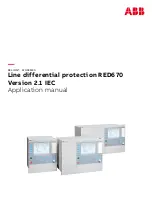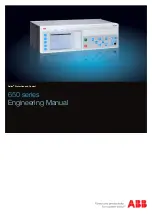
Refrigerating Specialties Division
4
OPERATION
The inlet pressure enters the space under the
diaphragm through passage N. When the
force created by the pressure exceeds the
force of the range spring, the diaphragm is
lifted off the pilot seat allowing pressure to
enter on top of the power piston. This causes
the power piston to move downward forcing
the throttling plug to open and modulate to
maintain constant inlet pressure. Increase in
inlet pressure lifts the diaphragm further,
allowing more pressure on top of the power
piston and opening the valve wider. Decrease
in inlet pressure causes the diaphragm to
move closer to the pilot seat reducing the
pressure on top of the piston and causing the closing spring to reduce
the valve opening. The pressure on top of the power piston is controlled
by the flow through the pilot seat and the bleed off through a bleed hole
in the power piston and through the clearance between the piston and
the cylinder. A maximum of 0.14 bar (2 psi) pressure drop across the
valve is required to open it fully.
The A4A Inlet Pressure regulator therefore opens on a rise in the inlet
pressure above its set point and closes on a drop in inlet pressure
below its set point. The inlet pressure set point is not appreciably affected
by variations in the outlet pressure.
MANUAL OPENING STEM
All Type A4A Regulators are provided with a manual opening stem. To
open the regulator manually, back the stem out (turn counter-clockwise)
until it stops. To put the regulator into automatic operation, turn the
stem in (clockwise) until only the flats on the stem protrude from the
stuffing box nut.
ADJUSTMENT
Install an accurate pressure gauge in the gauge port. Back the adjusting
stem all the way out to stop. This will reduce the set point to its lowest
level and cause the valve to open wide. Start the system, and when
suction pressure is about the desired pressure, turn the adjusting stem
in until the pressure gauge shows a slight rise in the inlet pressure. At
this point the adjusting stem may be turned in (clockwise) to raise the
pressure further, or backed out (counterclockwise) to lower it; but the
final adjustment should be made after the system has been operating
for a period of time.
INLET PRESSURE SETTING RANGES
Set Point Ranges
Approx. Pressure Change
per Turn of Adjusting Screw
A: 0 to 11 bar (0 to 150 psig)
1.8 bar (25 psi)
V: 500 mm hg to 8 bar
1.8 bar (25 psi)
(20 in hg to 120 psig)
D: 5 to 20 bar (75 to 280 psig)
3.7 bar (53 psi)
A4AE INLET PRESSURE REGULATOR,
REMOTE SENSING CONNECTION
This regulator allows control of upstream pressure at a point remote
from the regulator inlet. The Adapter 28 is rotated one bolt hole to block
the flow through passage N to under the diaphragm. The sensing
pressure from the desired control point, upstream of the regulator, is
connected to the gauge port leading to under the diaphragm. Thus the
regulator will control the pressure at this point. The regulator operation
and adjustment is the same as for A4A.
A4AK RESEATING RELIEF REGULATOR
This regulator is adjusted at the factory for a given inlet pressure relief
setting. The seal cap is wired to a bonnet cap screw and the wires are
sealed with a lead seal. The relief pressure setting is stamped on the
seal. Breaking or removal of the seal voids the factory responsibility
for the relief pressure setting of the regulator.
The operation and other construction features are similar to A4A, except
that sizes 20mm (3/4") through 32mm (1-1/4") use a teflon seat in the
throttling plug.
Because of slight leakage tolerance, this regulator is not intended for
use as a system relief regulator to the atmosphere, but rather to a
lower pressure section of that system. Because of large diaphragm to
seat area ratio, setting is affected only slightly by outlet pressure.
This regulator is often used as a defrost pressure relief regulator.
A4AL DIFFERENTIAL PRESSURE REGULATOR
When it is desired to control the differential
pressure between the regulator inlet and
outlet, this regulator is necessary. The outlet
pressure is introduced through a sensing
tube, which is part of the Flange Ring-tube
Assembly 20, from the outlet of the regulator
into the bonnet and to the top of the
diaphragm, thus allowing the regulator to
maintain a differential pressure between the
inlet and outlet equivalent to the spring
setting.
For adjustment, pressure gauges should be
connected to the gauge port at the regulator
inlet and also downstream of the regulator.
With the system operating, back the adjusting
stem all the way out to stop (counter-clockwise) to give minimum
differential, which is about 0.14 bar (2 psi). Gradually turn the adjusting
stem in (clockwise) until the desired differential pressure is reached,
assuming the system is capable of achieving such a differential. Check
the differential setting after the system has been in operation for a
while and make any minor corrections necessary.
A4AO and A4AOE
Remove the sensing tube connection which is part of the Flange Ring
tube Assembly 20 (A4AO) or the external sensing connection to the
adapter 7A (A4AOE). Disassemble following the General Procedure.
Remove the A4AO adapter. Disassemble the Pilot Plug 24 and Spring
23 by inserting a screwdriver in the slot in the bottom of the pilot plug
and turning the Spring Nut 22 with a wrench. Inspect the pilot plug and
the matching surface on the Adapter 21 for dirt and damage. Clean, lap
in place or replace as needed. Assemble new “O” Ring 26 to the pilot
plug and carefully insert the assembly into the adapter. Reassemble
the pilot plug, spring and spring nut. Replace “O” Ring 25. Reassemble
regulator following the General Procedure.
A4A INLET PRESSURE REGULATOR






























